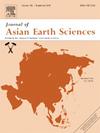A deformation-based seismic hazard model for the Makran region
IF 2.7
3区 地球科学
Q2 GEOSCIENCES, MULTIDISCIPLINARY
引用次数: 0
Abstract
The most prevalent approach for evaluating earthquake hazard is the probabilistic seismic hazard analysis (PSHA), which commonly relies on earthquake catalogs. However, in subduction zones like Makran, southeast Iran where the return period of large-magnitude (Mw 7+) characteristics events is more than ∼1000–2000 years, the complementary data from deformation models are crucial to put more efficient constraints on the seismicity activity. An alternative method to address this issue, known as deformation-based PSHA involves estimating activity rates from deformation-based strain rates. Here, we estimate the earthquake occurrence rates for events with Mw 4+ using strain rates derived from a comprehensive deformation model of the Makran region, using complementary regional seismicity parameters, such as and . As a representative, we selected a limited number of points in each seismic province and compared them to their long-term activity rate estimations based on available catalogs. Our deformation-based hazard model estimates higher hazard levels than other catalog-based models, for a substantial portion of the study area.
基于形变的马克兰地区地震危险性模型
评估地震危险性最普遍的方法是概率地震危险性分析(PSHA),它通常依赖于地震目录。然而,在伊朗东南部的Makran等俯冲带,大震级(Mw 7+)特征事件的返回周期超过~ 1000-2000年,变形模型的补充数据对于更有效地约束地震活动至关重要。解决这个问题的另一种方法是基于变形的PSHA,它包括根据基于变形的应变率估计活动速率。在这里,我们使用从Makran地区的综合变形模型中得到的应变率,使用互补的区域地震活动参数,如β和mmax,来估计m4 +事件的地震发生率。作为代表,我们在每个地震省选择了有限数量的点,并将它们与基于可用目录的长期活动率估计进行比较。我们的基于变形的危险模型估计的危险水平比其他基于目录的模型高,对于研究区域的很大一部分。
本文章由计算机程序翻译,如有差异,请以英文原文为准。
求助全文
约1分钟内获得全文
求助全文
来源期刊

Journal of Asian Earth Sciences
地学-地球科学综合
CiteScore
5.90
自引率
10.00%
发文量
324
审稿时长
71 days
期刊介绍:
Journal of Asian Earth Sciences has an open access mirror journal Journal of Asian Earth Sciences: X, sharing the same aims and scope, editorial team, submission system and rigorous peer review.
The Journal of Asian Earth Sciences is an international interdisciplinary journal devoted to all aspects of research related to the solid Earth Sciences of Asia. The Journal publishes high quality, peer-reviewed scientific papers on the regional geology, tectonics, geochemistry and geophysics of Asia. It will be devoted primarily to research papers but short communications relating to new developments of broad interest, reviews and book reviews will also be included. Papers must have international appeal and should present work of more than local significance.
The scope includes deep processes of the Asian continent and its adjacent oceans; seismology and earthquakes; orogeny, magmatism, metamorphism and volcanism; growth, deformation and destruction of the Asian crust; crust-mantle interaction; evolution of life (early life, biostratigraphy, biogeography and mass-extinction); fluids, fluxes and reservoirs of mineral and energy resources; surface processes (weathering, erosion, transport and deposition of sediments) and resulting geomorphology; and the response of the Earth to global climate change as viewed within the Asian continent and surrounding oceans.
 求助内容:
求助内容: 应助结果提醒方式:
应助结果提醒方式:


